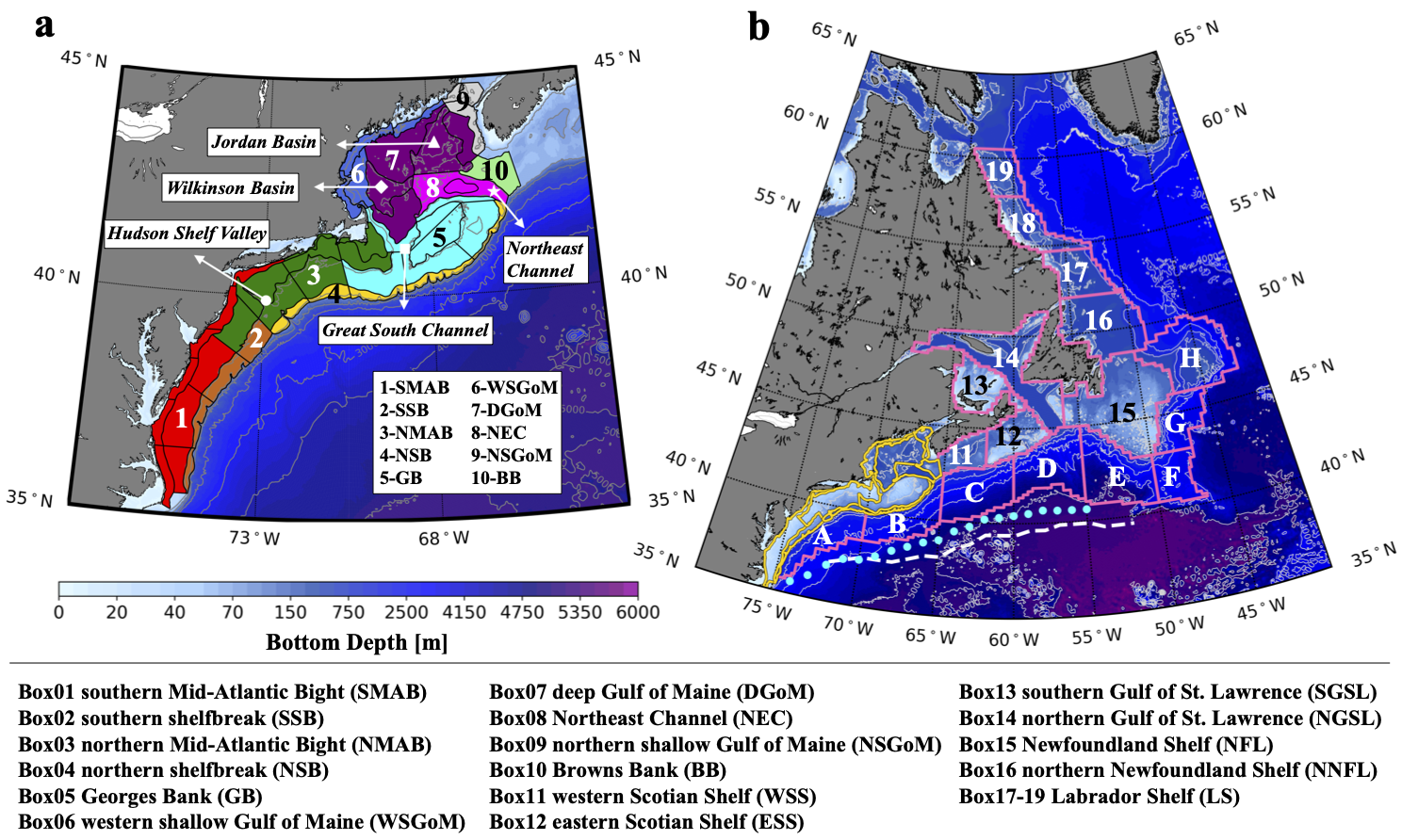Projects
Seasonal Prediction of Bottom Temperature on the Northeast U.S. Continental Shelf
Here, we have developed a hierarchy of statistical seasonal predictions for NES bottom temperatures using an eddy-resolving ocean reanalysis data set, as the current generation of climate model-based seasonal-to-interannual predictions exhibits limited prediction skill in this continental shelf environment.
- A simple, damped local persistence prediction model produces significant skill for lead times up to ∼5 months in the Mid-Atlantic Bight and up to ∼10 months in the Gulf of Maine, although the prediction skill varies notably by season.
- Considering temperature from a nearby or upstream (i.e., more poleward) region as an additional predictor generally improves prediction skill, presumably as a result of advective processes.
- Large-scale atmospheric and oceanic indices, such as Gulf Stream path indices (GSIs) and the North Atlantic Oscillation Index, are also tested as predictors for NES bottom temperatures.
- Only the GSI constructed from temperature observed at 200 m depth significantly improves the prediction skill relative to local persistence. However, the prediction skill from this GSI is not larger than that gained using models incorporating nearby or upstream shelf/slope temperatures.
- Based on these results, a simplified statistical model has been developed, which can be tailored to fisheries management for the NES.
 Figure 1. The Northeast U.S. shelf (NES) is an oceanographically dynamic marine ecosystem and supports some of the most valuable demersal fisheries in the world. A reliable prediction of NES environmental variables, particularly ocean bottom temperature, could lead to a significant improvement in demersal fisheries management. Figure Source
Figure 1. The Northeast U.S. shelf (NES) is an oceanographically dynamic marine ecosystem and supports some of the most valuable demersal fisheries in the world. A reliable prediction of NES environmental variables, particularly ocean bottom temperature, could lead to a significant improvement in demersal fisheries management. Figure Source
 Figure 2. The prediction skills for the western shallow Gulf of Maine (WSGoM), deep Gulf of Maine (DGoM), and Northeast Channel (NEC), in ACC of the persistence–advection model (a–c) and the skill improvement relative to the local persistence model (d–f), in RMSE (g–i), and in the Brier Skill Score (BSS) for upper (j–l) and lower (m–o) terciles. Figure Source
Figure 2. The prediction skills for the western shallow Gulf of Maine (WSGoM), deep Gulf of Maine (DGoM), and Northeast Channel (NEC), in ACC of the persistence–advection model (a–c) and the skill improvement relative to the local persistence model (d–f), in RMSE (g–i), and in the Brier Skill Score (BSS) for upper (j–l) and lower (m–o) terciles. Figure Source
Check out the paper here›
Other Projects
- Projects · Projecting future changes in the Gulf Stream warm-core rings and their impacts on the Northeast U.S. Large Marine Ecosystem in a changing climate using regional MOM6 simulations
- Projects · Skillful multiyear prediction of marine habitat shifts jointly constrained by ocean temperature and dissolved oxygen
- Projects · Seasonal Prediction of Bottom Temperature on the Northeast U.S. Continental Shelf
- Projects · Interannual Variability of the Mid-Atlantic Bight Cold Pool
- Projects · Long-term SST Trends over the Northwest Atlantic Shelf & Slope
- Projects · Seasonal Variability of the Mid-Atlantic Bight Cold Pool